How arthritis impacts sleep
If you have arthritis, chances are you’re dealing with chronic pain due to inflammation and swelling of joints. Arthritis comes in many forms, and all of them cause discomfort. Osteoarthritis, the type caused by wear-and-tear on the joints, is the most common, affecting 32.5 million U.S. adults, according to the Centers for Disease Control and Prevention (CDC). It gets more common as people age, and the cartilage in the joints can wear down.
Other types include gout and rheumatoid arthritis, an autoimmune reaction in which the body mistakenly attacks its own tissues. Rheumatoid arthritis (RA) affects 1.5 million people in the US, two-thirds of whom are women.
No matter what type of arthritis you have, the associated pain is likely affecting your sleep. According to the CDC, nearly 30 percent of people with arthritis are getting less than the recommended seven hours of sleep a night. A 2018 study published in Arthritis Care & Research found that 34 percent of osteoarthritis patients experienced insomnia as well as moderate-to-severe pain. Another 2018 study in the Journal of Clinical Medicine in RA patients found 57 percent reported getting less than the optimal amount of sleep, which was also linked to pain level.
“Pain is the largest barrier to sleep,” says Carole Dodge, an occupational therapist at the University of Michigan Health System, in Ann Arbor, who specializes in arthritis. Arthritis patients may have “difficulty in finding a position in bed where joint pain is alleviated. This is so that pain doesn’t interfere with falling or staying asleep when changing position in bed. This can contribute to poor sleep.” In addition, the general stress of having a chronic pain condition can also lead to trouble sleeping.
But, one of the things doctors wish you knew about arthritis is how to increase your chances of getting better sleep with the condition. Read on for tips from our experts.
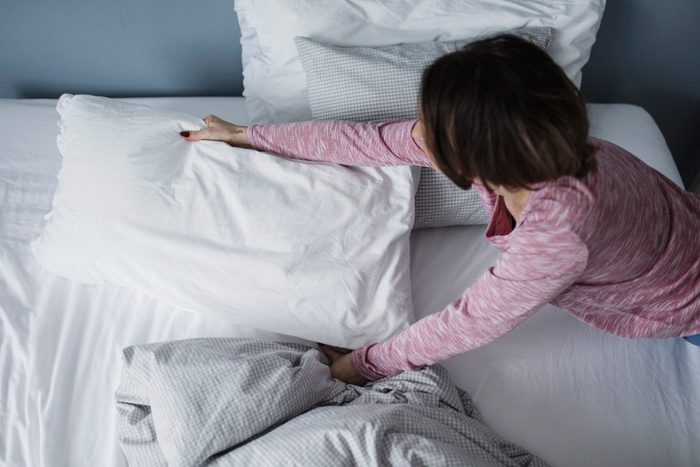
Make your bed comfy
In order to get a good night’s sleep with arthritis, you have to be able to get comfortable; but what that means is going to be different for different people. “There is considerable personal preference in mattresses,” Dodge says. “A mattress should be firm enough so that it allows the person to be able to be mobile turning from side to side, or back to side.
If the mattress is too soft, this can make it more difficult to move in bed; if the mattress is too firm, it may not help to cushion the painful joints enough.” The trick is to finding one that not too firm, not too soft, but just right for your comfort level.
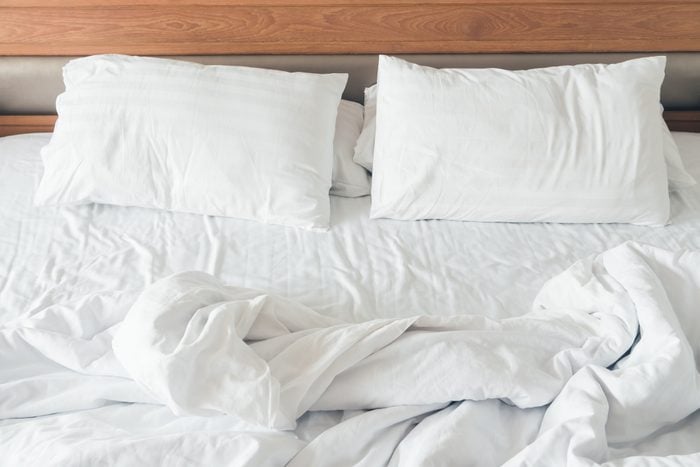
Use pillows and blankets wisely
Your bedding can also assist you in achieving maximum comfort. “Pillows can be helpful to position both upper extremity and lower extremity joints for comfort,” Dodge says. “But we do not suggest more than one pillow behind the head.” This can put the neck at an unnatural angle. “The spine has to be aligned correctly,” says Rajat Bhatt, MD, a rheumatologist at Prime Rheumatology in Texas. If not, “this can interfere with proper sleep.” Sleeping position is also a personal preference, but he recommends laying on your back.
Today, pillows come in a variety of shapes to choose from depending on where you need support, where your arthritis is located, and what feels good for you. For example, if you’re a side sleeper, try putting a pillow between your knees.
As for blankets, “they are often helpful, but if they’re too heavy they can be difficult to pull up,” Dodge says. You want to make sure you can move easily throughout the night. Avoid these other ways you’re probably sleeping wrong.

Set the temperature
Another factor that can affect an arthritis patient’s comfort level at night is how warm the room is. In general, the National Sleep Foundation recommends a cool room for best sleep practices, between 60 and 67 degrees. But, “it’s cooler at night so this can exacerbate pain,” Dr. Bhatt says.
For this reason, Dodge says you don’t want to keep the room too cold. “Temperature in the room should be warm enough so that people are not chilled, which can lead to muscles tightening and contribute to joint pain,” she says.
Rheumatologist Yvonne C. Lee, MD, an associate professor of medicine at Northwestern University Feinberg School of Medicine, in Chicago, says it’s again a matter of what works for you. “Cool temperatures tend to be better for sleep,” she says. “Other sources say anything up to 75 degrees, depending on other factors such as the type of bedding and sleepwear.”
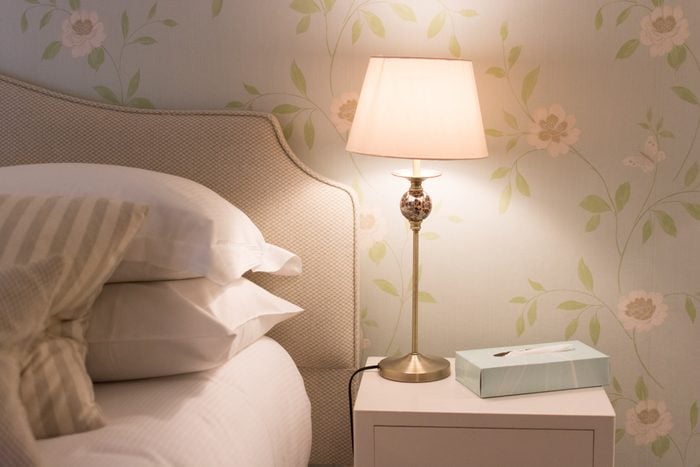
Turn down the lights
Not surprisingly, a darker room is better for sleep; and this advice that goes for the general public is particularly important for people with arthritis. “The room should be as dark as possible,” Dr. Lee says. “Consider investing in blackout curtains or eye shades.” Particularly in summer, blackout curtains can help keep out the bright early morning light that can lead to waking up too soon.
However, “night lights for safety may be helpful especially if getting up at night is necessary,” Dodge says. Then during the day, be sure to get plenty of natural light: The National Sleep Foundation says exposure to sunlight, along with darkness at night, helps our body get on a good sleep-wake cycle.
In addition, turn off bright lamps at night in favor of dim lighting. It’s one of the little changes you can make to sleep better.
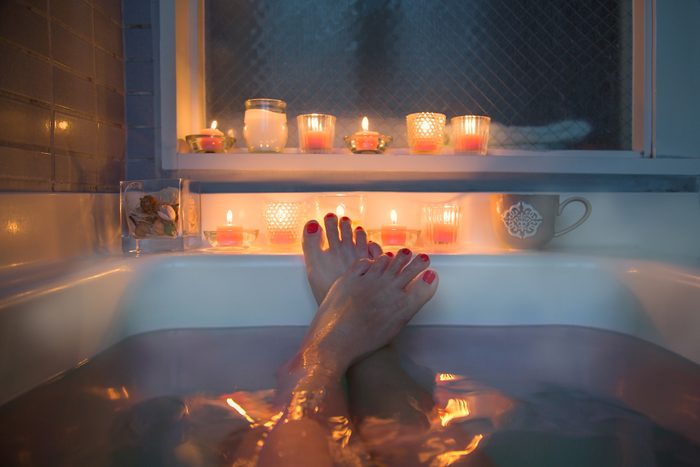
Create a calming bedtime routine
Routines are helpful in general because they signal to the body that it is nearing bedtime, Dr. Lee says. “Routines that help with relaxation may be particularly helpful if stress and/or anxiety are contributing to difficulty sleeping,” she says. “Some arthritis patients find that a warm shower helps minimize stiffness and pain. A warm shower or bath has also been suggested to decrease the time falling asleep in a variety of populations including older individuals, though not specifically patients with arthritis.”
Dodge also recommends using heat. If you have arthritis in your hands, “using paraffin wax on the hands before bed for 15 to 20 minutes can lessen pain and allow patients to fall and stay asleep,” she says. “Warm showers and heating pads on the most painful joints for 15 to 20 minutes will help relieve muscle tightness and joint pain.”

Engage in relaxing activities before bed
In addition to soothing the body, you can soothe your mind before bed as well. “In some cases, anxiety about pain or joint destruction may also contribute to difficulty sleeping,” Dr. Lee says. If you’re associating the nighttime with pain, try to lower your stress level before bed. “Reading a book on an enjoyable topic will help take the focus off the self and facilitate the person to get immersed in the stories and characters,” Dodge says.
Dr. Bhatt suggests deep breathing or listening to music. Avoid stressful news reports or social media if it upsets you. Also, “no screens,” Dodge says. Dr. Lee says to keep the TV off, as well as avoiding your cell phone.
According to the National Sleep Foundation, the light from screens can make it difficult to sleep. But other technology may aid relaxation: “White noise machines can also create a soothing environment, and help when stressed to fall asleep,” Dodge says.
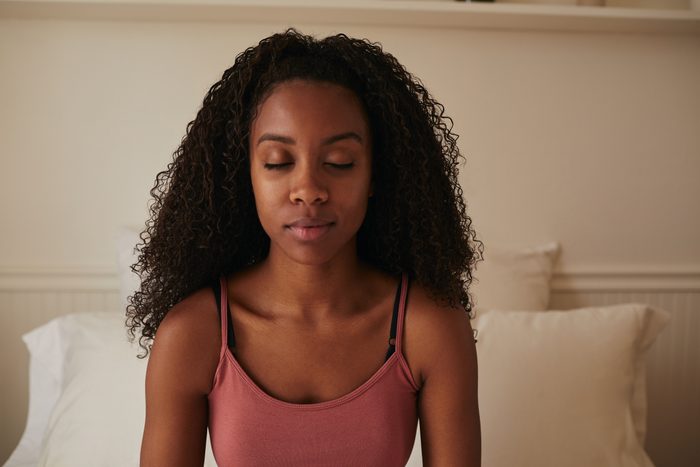
Practice meditation
A better sense of calm through meditation may make it easier to fall asleep at night. “Mindfulness meditation does help, and there are several meditation techniques helping to focus the thought process away from pain,” Dr. Bhatt says. By lowering your perception of pain, meditation may be able to alter the body’s response to it.
Dodge recommends an app called Headspace for meditation and mindfulness. Plus, “the premium version has bedtime stories in a soothing voice,” she says.
Research on meditation and arthritis specifically is still emerging, but one 2015 study in JAMA Internal Medicine showed an improvement in sleep quality in older adults who practiced meditation; a 2017 review in Annals of Behavioral Medicine found improvements in sleep among people with chronic pain who meditated. Meditation is one of the arthritis home remedies doctors strongly recommend.
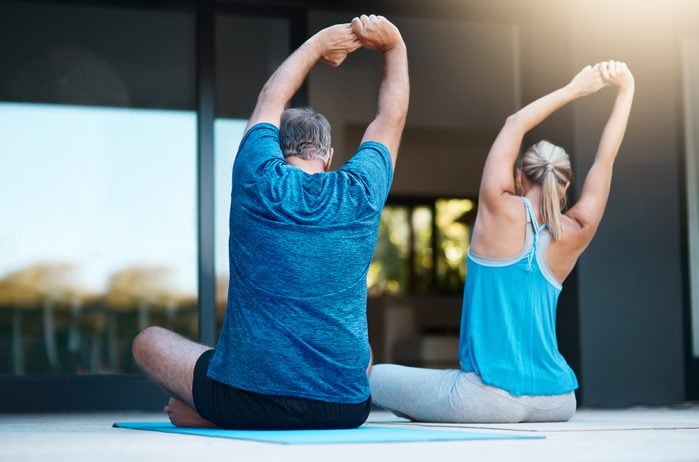
Try tai chi or yoga
Dr. Bhatt also recommends the gentle motions and deep breathing of a tai chi practice for achieving nighttime calm. One 2016 study in Annals of Internal Medicine found tai chi just as effective as physical therapy in reducing pain and disability from knee osteoarthritis; the American College of Rheumatology strongly recommends tai chi for knee or hip osteoarthritis in its 2019 guidelines. A 2019 Cochrane review was a little less clear on the benefits for RA, although the risks are likely to be low.
You can also try yoga, which also involves deep breathing and a mind/body approach that may help reduce pain. “A few small studies have suggested that yoga may help patients with arthritis get better sleep, but, to my knowledge, no large scale clinical trials have been published,” Dr. Lee says. For either tai chi or yoga, talk to your doctor first to make sure it’s OK for you. Tai chi has also been proven to help prevent falls in seniors.

Get exercise during the day
Whatever kind of physical activity you choose, exercise is the first-line treatment for arthritis, and it has the added benefit of being a natural sleep aid. “Studies validate that getting regular exercise contributes to improved sleep,” Dodge says. “Exercise and movement have been found to be the number one non-pharmacological intervention for arthritis.” The CDC recommends 150 minutes of moderate exercise a week for everyone, including those with arthritis.
You can decide what kind of exercise you prefer. “Several clinical trials have shown that exercise programs, both land-based and aquatic, significantly reduce pain in patients with osteoarthritis,” Dr. Lee says. “Exercise may also have additional benefits, as studies also show that daytime exercise is associated with improvements in nighttime sleep in the general population.
It is important, however, that exercise is done during the day, as opposed to close to bedtime, as exercise close to bedtime may make it more difficult to fall asleep.” Dr. Bhatt advises that exercise be completed at least several hours before bed.
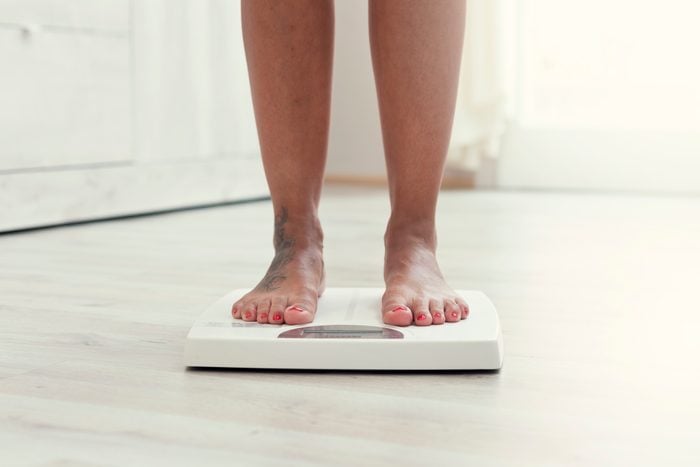
Losing weight may help
You might not associate weight with difficulty sleeping, but there is a link. “Lowering body mass helps to reduce stress on weight-bearing joints,” says Dodge. “Losing weight may help reduce the amount of pain at the end of the day and interfere less with sleep.” According to the CDC, obesity is a risk factor for arthritis; people who are obese are more likely to develop joint problems.
But, a 2018 study in Arthritis Care & Research showed that losing 10 to 20 percent of body weight improved pain in knee arthritis patients. “Losing weight does help especially lower extremity arthritis pain,” says Dr. Bhatt. Keeping your weight in check is one of the everyday habits that reduce your risk of arthritis symptoms.
Another connection between obesity and arthritis is that both conditions are linked to sleep apnea, a breathing problem that can cause waking during sleep. “All potential causes of sleep problems in the general population, such as obstructive sleep apnea, can also affect patients with arthritis and, in fact, may be more common among patients with osteoarthritis and rheumatoid arthritis,” Dr. Lee says. Losing weight can help reduce the chances of sleep apnea.

Manage mental health
While meditation may help to reduce stress, you should also consider additional stress management if necessary. “The stress of having a chronic disease and how that affects every aspect of a person’s life contributes to poor sleep,” Dodge says. “It is difficult to clear your mind when worried about health, finances, relationships, and continued ability to function with daily activities.”
You may want to pursue therapy with a licensed counselor or psychologist. Dr. Bhatt suggests cognitive behavioral therapy, a technique that retrains your brain to avoid negative thought patterns. “Cognitive behavioral therapy for insomnia is a well-established treatment for sleep disturbances, but usually requires referral to an appropriate specialist,” agrees Dr. Lee.
In addition, treating any mental health issues, including anxiety and depression, which often co-exist with chronic pain conditions including arthritis, may improve sleep, suggests a 2015 study in Arthritis Care & Research.
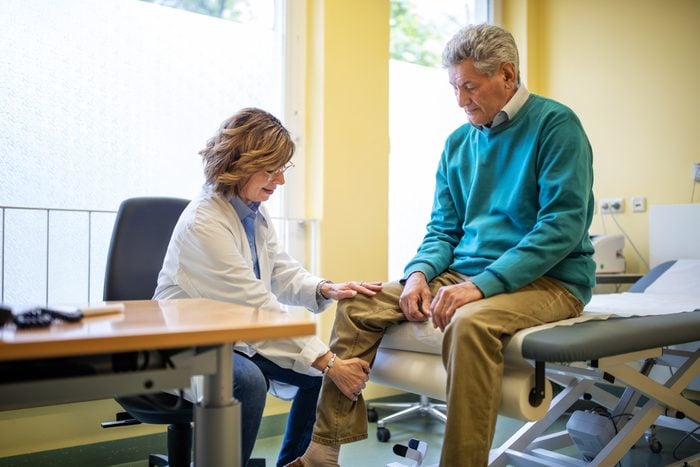
Make sure arthritis is well-controlled
Along with following lifestyle recommendations to improve your sleep with arthritis, make sure you’re under a doctor’s care and following their directions to ensure your arthritis is controlled. “Any steps to control your disease, whether it be taking medications to decrease inflammation for patients with rheumatoid arthritis or losing weight for patients with osteoarthritis, may help you sleep better at night because pain negatively impacts sleep,” Dr. Lee says.
Under your doctor’s direction, you could also explore things like cannabidiol (CBD) to improve sleep, or other alternative remedies. However, whatever alternative techniques you decide to try to improve your sleep, make sure you get your doctor’s approval first.

